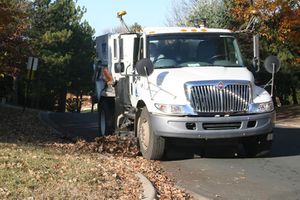
Category:Level 3 - Best management practices/Nonstructural practices/Street sweeping
Street sweeping (also called street cleaning) refers to removal of sediment, litter, or other accumulated substances on roadways, particularly in urban and suburban areas. Street sweeping does not include removal of large quantities of leaves brought to the street/verge for removal, large debris or bulky items; removal of these items is typically handled by large vacuum leaf collectors or dump trucks, respectively.
Historically, street sweeping was conducted manually by a sanitation worker with a broom or shovel to remove animal waste from horse-drawn vehicles and other detritus on roadways. Mechanical sweepers such as broom systems attached to horse carts came about in the mid-1800s, and in the early 1900s street cleaning wagons sprayed water onto roadways to wash away debris. Motor-driven street sweeping vehicles were patented in the US in 1917.
Modern street sweeping has improved efficiency of debris removal from roadways dramatically. The focus of street sweeping was simple large “cosmetic” debris removal until the 1970s when concerns about water quality arose. In the decades following, improvements in street sweeping technology focused more on the removal and collection of coarse sand particle-sized street dirt, and smaller particles which contribute to instream sediment and nutrient pollution when swept off of or washed into waterways. Even when a street was cleaned of large refuse, the amount of tiny particulate matter that could not be effectively removed manually remained to wash-off into waterways following precipitation. Pollutants in stormwater runoff have long been recognized as contributors to aquatic habitat degradation, nuisance algal growth, low dissolved oxygen and toxicity in receiving water bodies. More recently, there has been a focus on street sweeping to remove the organic matter produced by street trees (leaves, seeds, flowers, etc), which can contribute significant amounts of phosphorus to runoff, especially in the fall during leaf drop. Particulate matter (air) also poses significant air-quality concerns when entrained in the air due to wind.
This page contains links to pages that provide information on street sweeping for water quality.
Pages in category "Level 3 - Best management practices/Nonstructural practices/Street sweeping"
The following 28 pages are in this category, out of 28 total.
C
M
R
S
- Street sweeping
- Street sweeping for trees
- Street Sweeping Phosphorus Credit Calculator
- Street Sweeping Phosphorus Credit Calculator How-to-Guide
- Street Sweeping Phosphorus Credit Calculator: User Guide
- Supporting information
- Survey of street sweeping crediting approaches
- Survey results for managing street sweeping materials
Media in category "Level 3 - Best management practices/Nonstructural practices/Street sweeping"
The following 12 files are in this category, out of 12 total.
- How-to-guide 12 20 2021 FINAL.pptx ; 1.79 MB
- Kalinosky2014StreetSweepingManual.pdf ; 4.89 MB
- Leaf P Research Selbig.pdf ; 1.76 MB
- Spreadsheet Calc draft F7A.xlsm.xlsx ; 174 KB
- Street sweeping survey.pdf ; 96 KB
